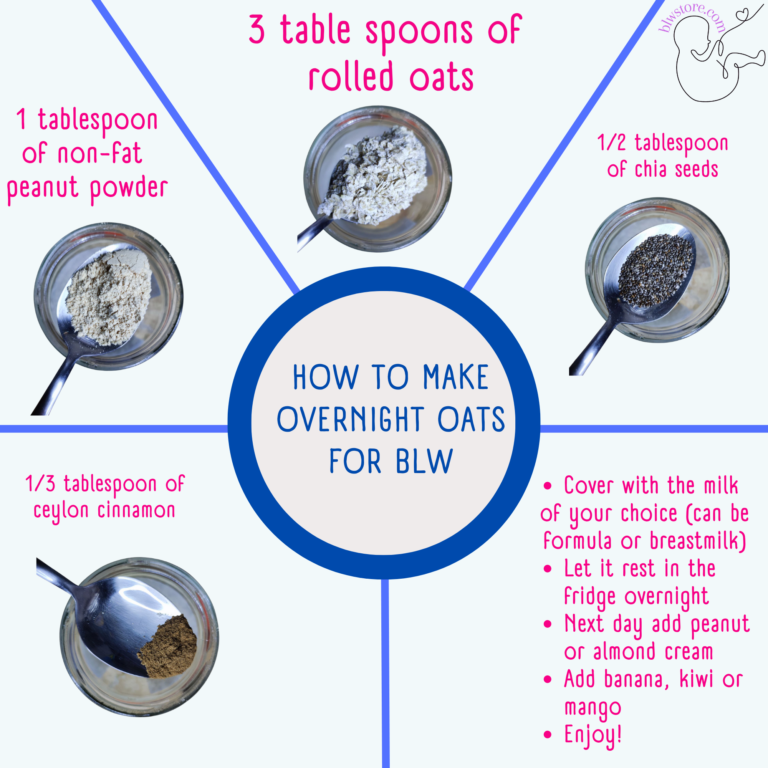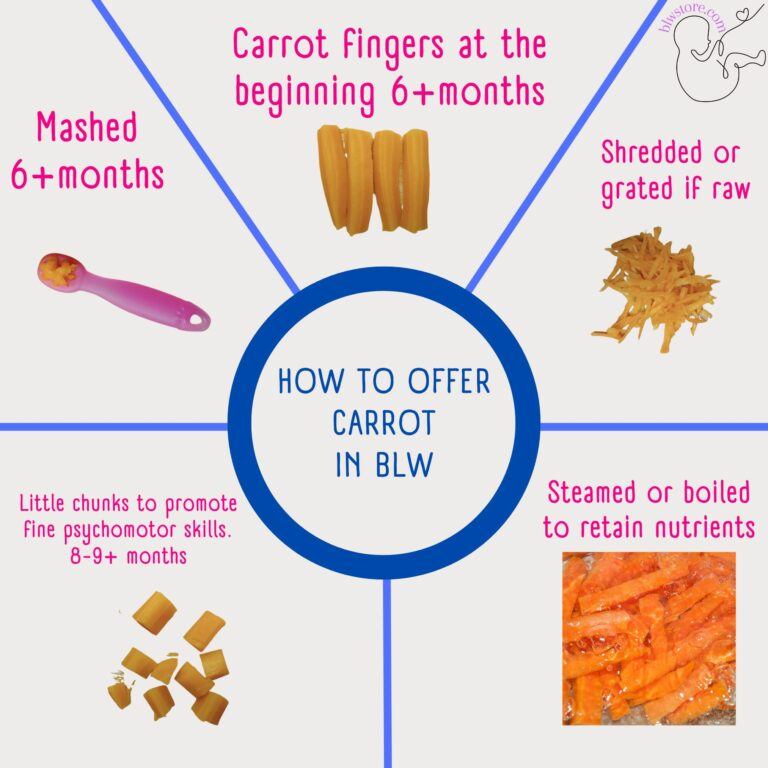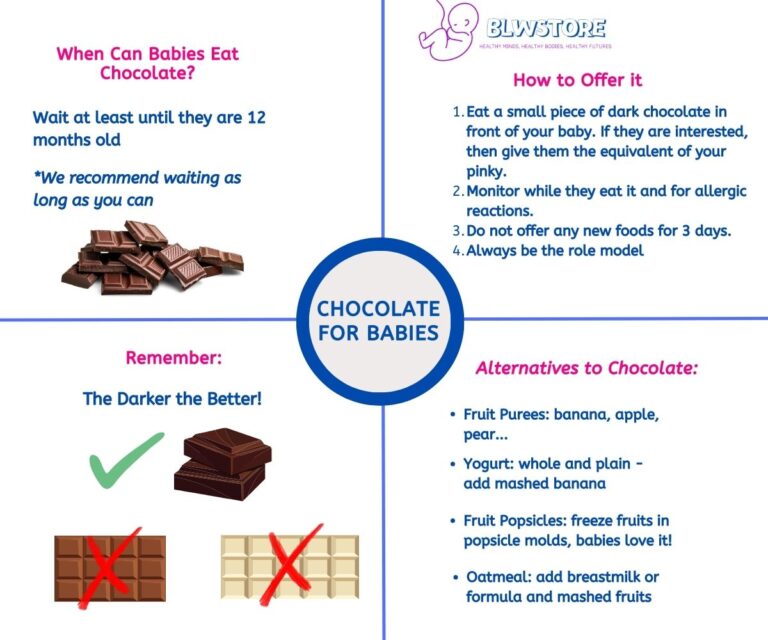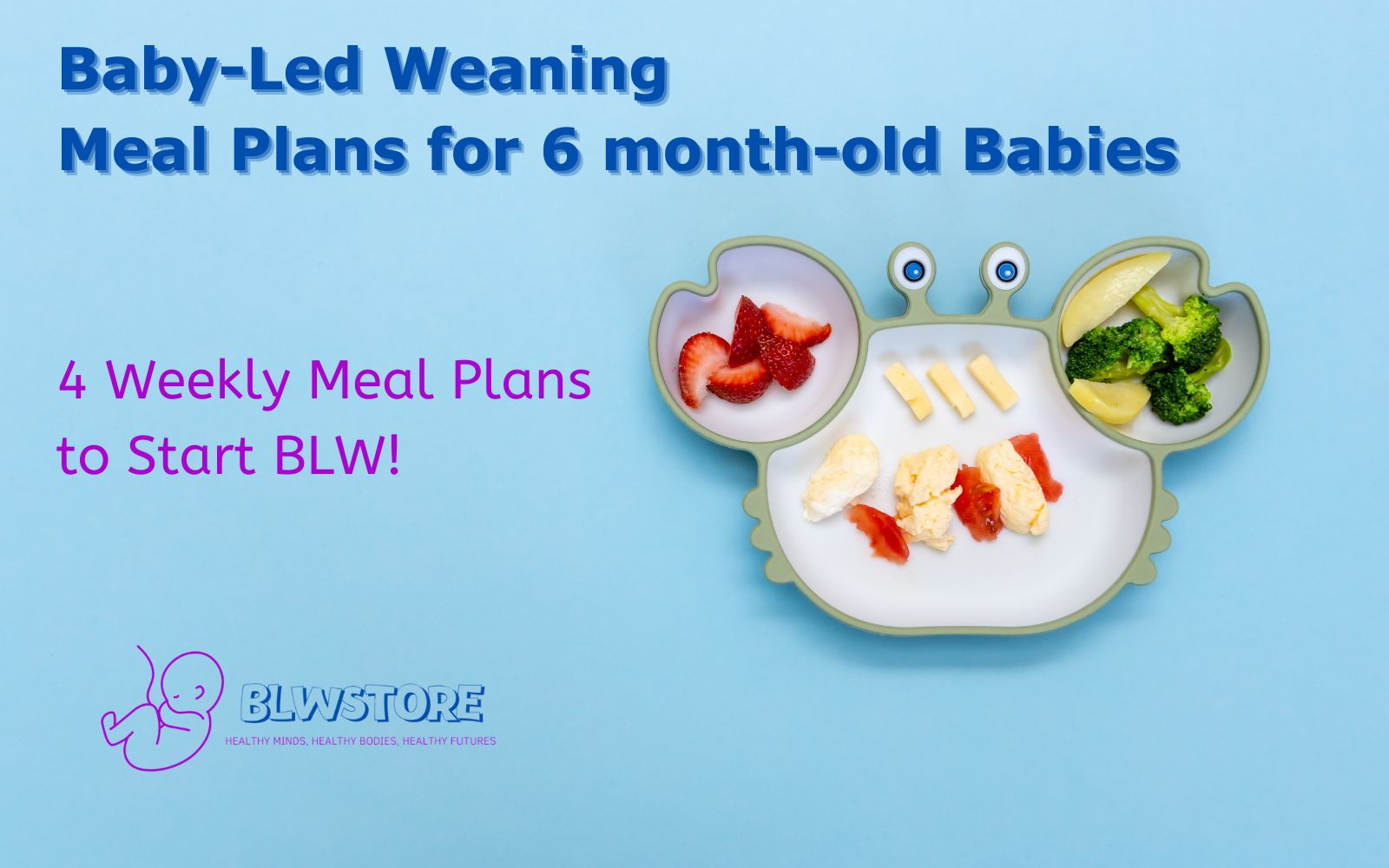
Starting with Baby-Led Weaning (BLW) is challenging, especially for new parents.
But fear not!
With proper guidance and well-planned meal plans, you can ensure your baby gets all the necessary nutrition while nurturing their curiosity and love for food.
Below are four carefully curated weekly meal plans for 6-month-old babies just starting their BLW journey.
Note: Knowing the theory behind the introduction of solids helps being more confident. If you are a new parent, we recommend you to read this article before starting with Baby-Led Weaning.
Keys to Successful Baby-Led Weaning
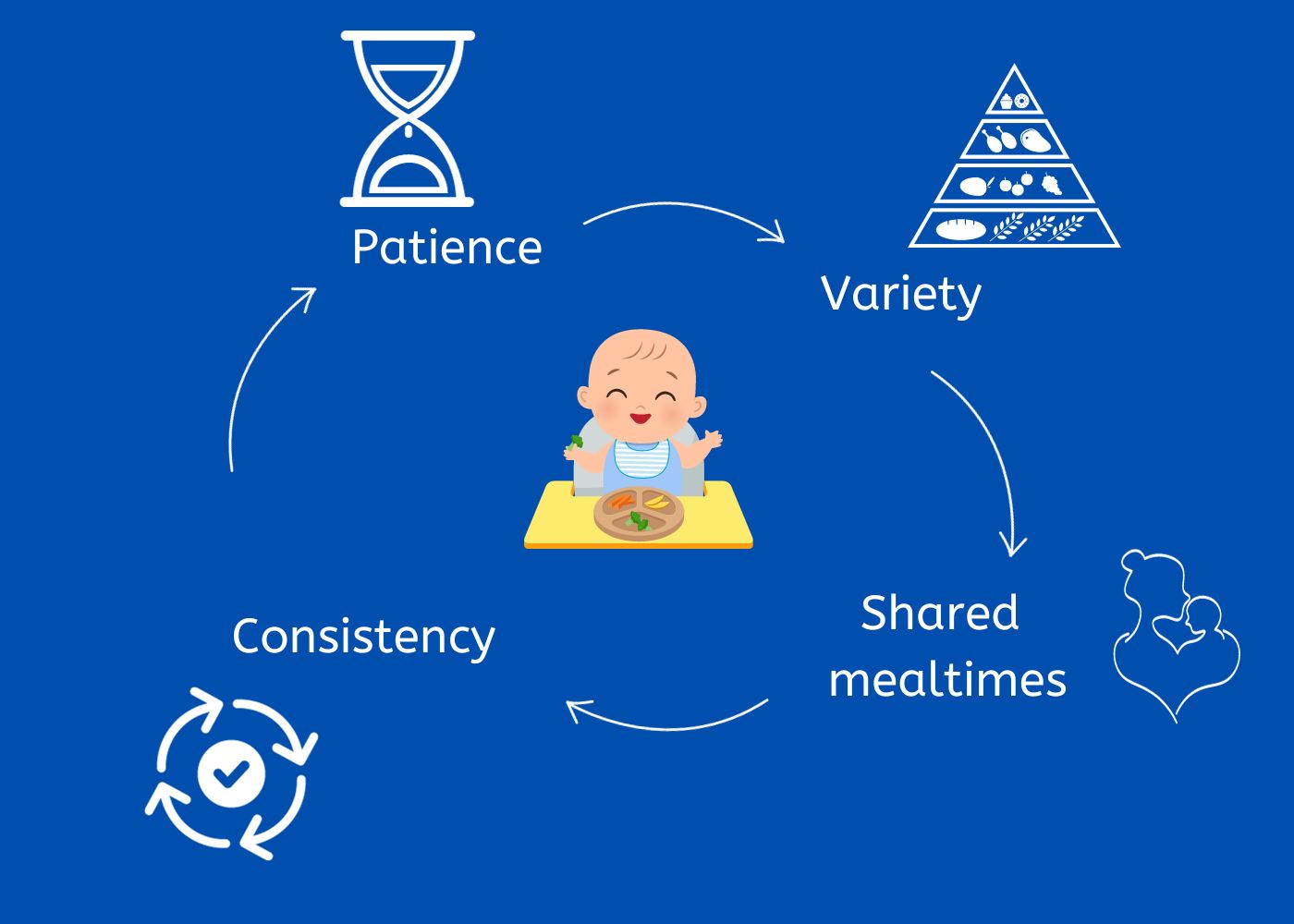
- Patience: Always keep in mind that it’s a gradual process. Your baby might take time to adjust, but consistently introducing different foods will eventually pique their interest.
- Variety: Offering an array of foods is key to ensuring balanced nutrition. It also helps your baby to discover different tastes, textures, and colors.
- Safety first: Always watch for choking hazards. Make sure the food is soft, easily compressed between your fingers, and is cut into manageable sizes.
- Consistency: Make mealtimes a routine. Consistency will help your baby adjust to this new meal structure and make the process smoother.
- Share mealtimes: Having family meals with your baby is optimal for creating a routine and for your baby to see you eating as well.
Why Choose Baby-Led Weaning for Your 6-month-old
Knowledge is power. The more you know about the benefits of Baby-Led Weaning, the more relaxed and confident you’ll feel about this new eating adventure.
- It supports baby’s developing motor skills: Baby-led weaning allows your little one to explore food by touching, smelling, tasting, and even playing with it. All these actions help strengthen your baby’s fine motor skills and hand-eye coordination.
- It encourages self-regulation: BLW trusts your baby to listen to their hunger and fullness cues. This teaches them to eat when hungry and stop when they’re full, fostering a healthy relationship with food in the long run.
- It promotes healthy eating habits: By introducing your baby to various foods from the start, you’re helping them develop a palate for different flavors and textures. This can reduce the likelihood of becoming a picky eater in later years.
- It eases mealtime stress: With BLW, you’re not stuck in the “parent feeds, baby eats” routine. Your baby can join family meals, making meal times less stressful and enjoyable.
Now, it’s worth noting that every baby is unique and will take to new foods and textures at their own pace. There’s no one-size-fits-all approach here. What we provide in this article are merely rough guides to help you get started on your baby’s exciting feeding journey. If your baby takes a little more or less time to get used to new foods, it’s perfectly normal. The key is patience and persistence.
Remember, the goal is not to stress or rush. It’s about creating a positive and enjoyable eating experience for your baby. So take a deep breath, relax, and let’s continue our Baby-Led Weaning adventure together!
Week 1: Introduction to Solids
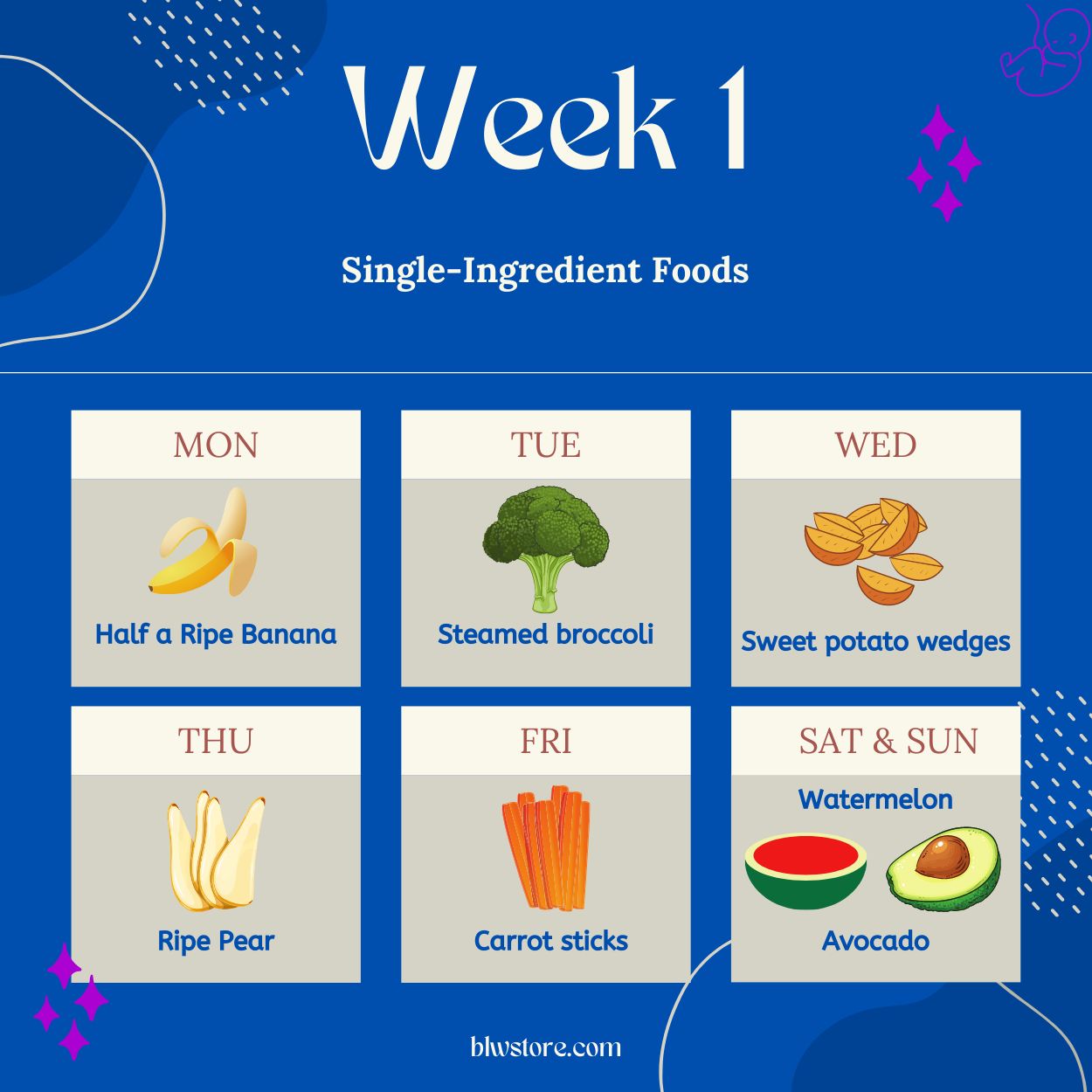
This week focuses on single-ingredient food items that are easy to handle, soft, and perfectly safe for your little gourmand. Remember, the idea here is to let your baby explore the food, so keep portions small and manageable.
- Day 1: Practice begins with half a ripe banana. The peel gives an excellent holding grip. Your baby might not eat much initially, but that’s perfectly okay.
- Day 2: Introduce steamed broccoli. The natural tree-like shape of broccoli makes it a fun and easy food for babies to handle.
- Day 3: Try steamed sweet potato wedges. They are easy to hold and chew on.
- Day 4: Serve a few slices of soft, ripe pear. Always keep watch for any untoward response.
- Day 5: On day five, offer boiled carrots as sticks. They have a lovely color that will intrigue your baby’s senses.
- Day 6: Introduce soft, seedless watermelon slices on the sixth day. It’s juicy and smooth, ideal for easing any teething discomfort your child might be experiencing.
- Day 7: Introduce avocados, a food rich in healthy fats, essential vitamins, and fibers.
Week 2: Introduction to Mixed Flavors
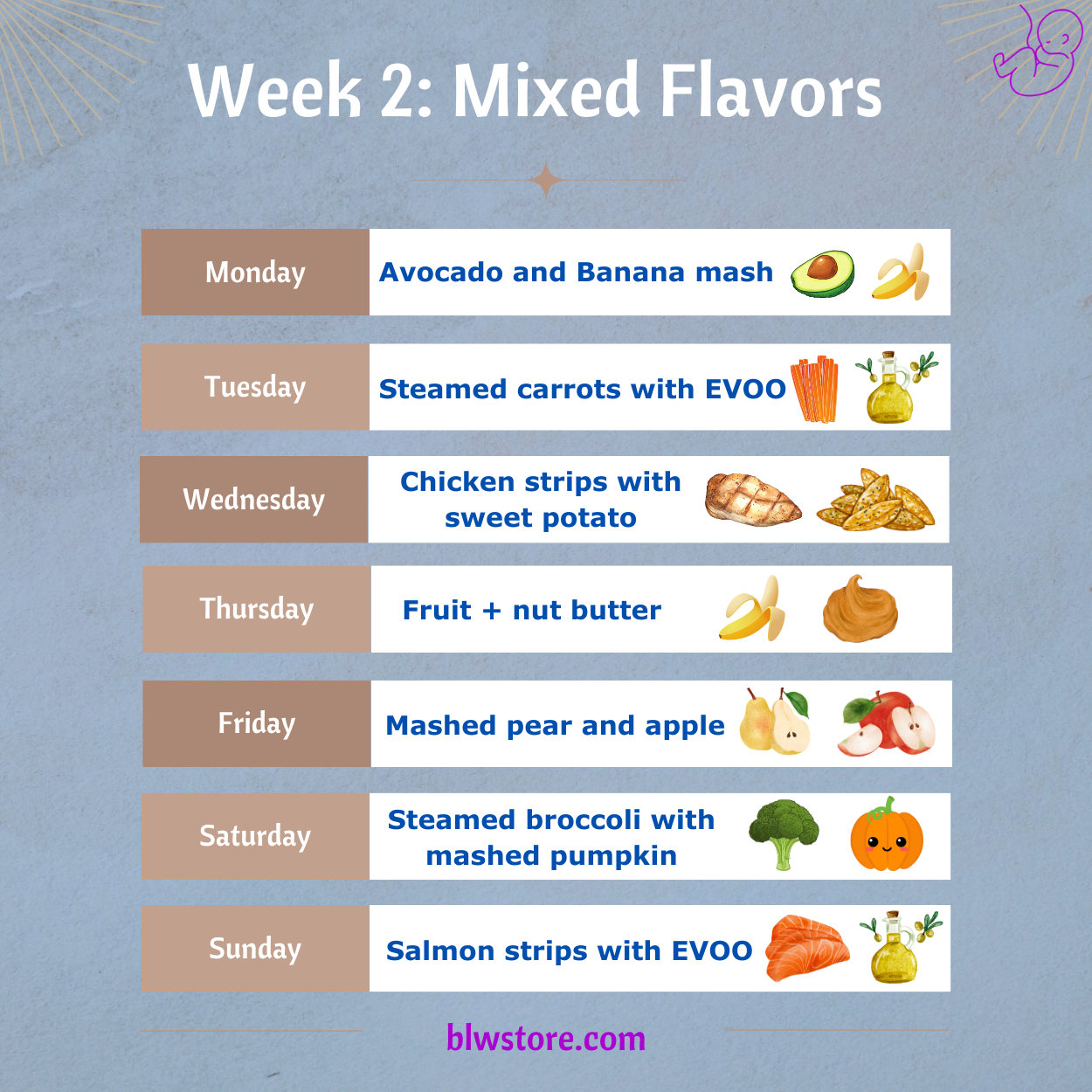
This week is all about introducing your baby to the world of mixed flavors. We will focus on combining different types of fruits, vegetables, and proteins to provide a more sophisticated palate for your little one.
Remember, patience is key. It’s perfectly normal for your baby to reject certain foods initially. Their taste buds are developing, and trying out new flavors is all part of the fun.
Also, remember that the primary focus is enjoying this journey with your baby. The nutrition is still mainly from their milk feeds.
A journey of a thousand miles begins with a single step. Each new flavor is a step towards a healthy eating adventure for your baby.
| Day | Meal | Food |
|---|---|---|
| Day 1 | Lunch | Avocado and banana mash |
| Day 2 | Dinner | Steamed carrots with olive oil |
| Day 3 | Lunch | Soft cooked chicken strips with sweet potato |
| Day 4 | Dinner | Any introduced fruit with peanut/almond butter |
| Day 5 | Lunch | Mashed pear and apple |
| Day 6 | Dinner | Steamed broccoli with mashed pumpkin |
| Day 7 | Lunch | Soft-cooked salmon strips with olive oil |
Always remember to introduce one new food at a time to your baby and observe them for any allergies or reactions.
The foods should be soft enough to squish between your fingers and cut into chip-shaped pieces for easy grip.
Week 3: Introduction to Grains
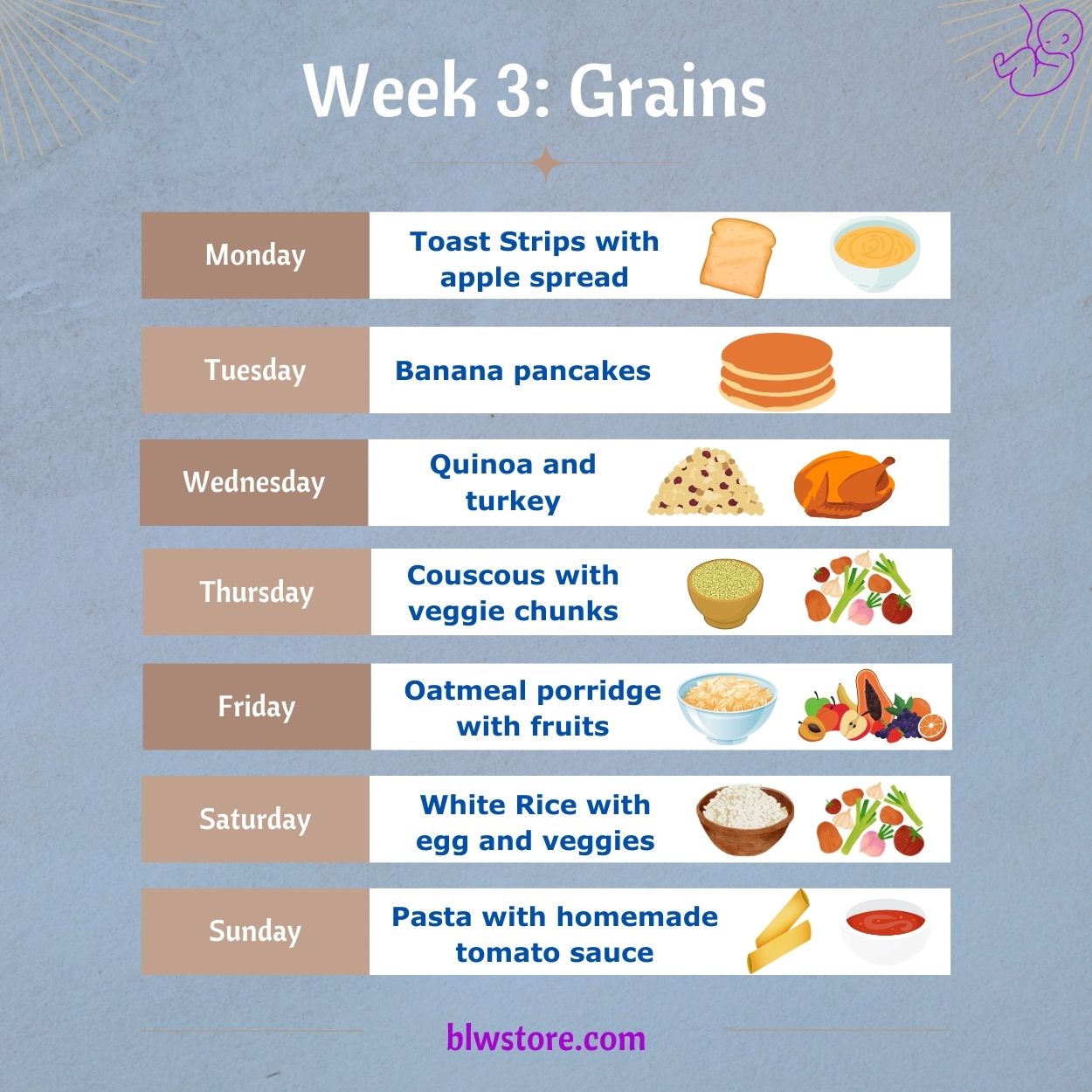
Welcome to week three, where you will introduce your baby to the exciting world of grains. This week will be about allowing your little one to explore these new flavors and textures independently.
| Day | Meal Plan |
|---|---|
| Day 1 | Toast strips with cooked apple spread |
| Day 2 | Banana pancakes (made with baby-approved flour) |
| Day 3 | Quinoa and poached turkey |
| Day 4 | Couscous with soft-cooked veggie chunks |
| Day 5 | Oatmeal porridge with fruits |
| Day 6 | Rice with soft-cooked veggies |
| Day 7 | Pasta with homemade tomato sauce |
Remember, every baby is different and will progress at their own unique pace.
You’re doing a great job, and exploring these new foods should be a fun and engaging experience for you and your baby.
Strive to embrace the mess and enjoy this new culinary adventure with your little one!
Patience, mama. Baby steps are the biggest steps of all.
Tips for Success During Week 3
- Start slow: Always start with a little, especially when introducing new grains. The idea is to let them explore the textures and flavors – not to fill their belly.
- Monitor closely: New textures also mean new challenges. Watch your baby closely during mealtimes to ensure they are swallowing comfortably and not choking.
- Try different grains: Feel free to experiment with different grains such as oats, cornmeal, barley, etc., but always ensure that they are cooked to an appropriate softness.
Week 4: Introducing Organs and More Proteins
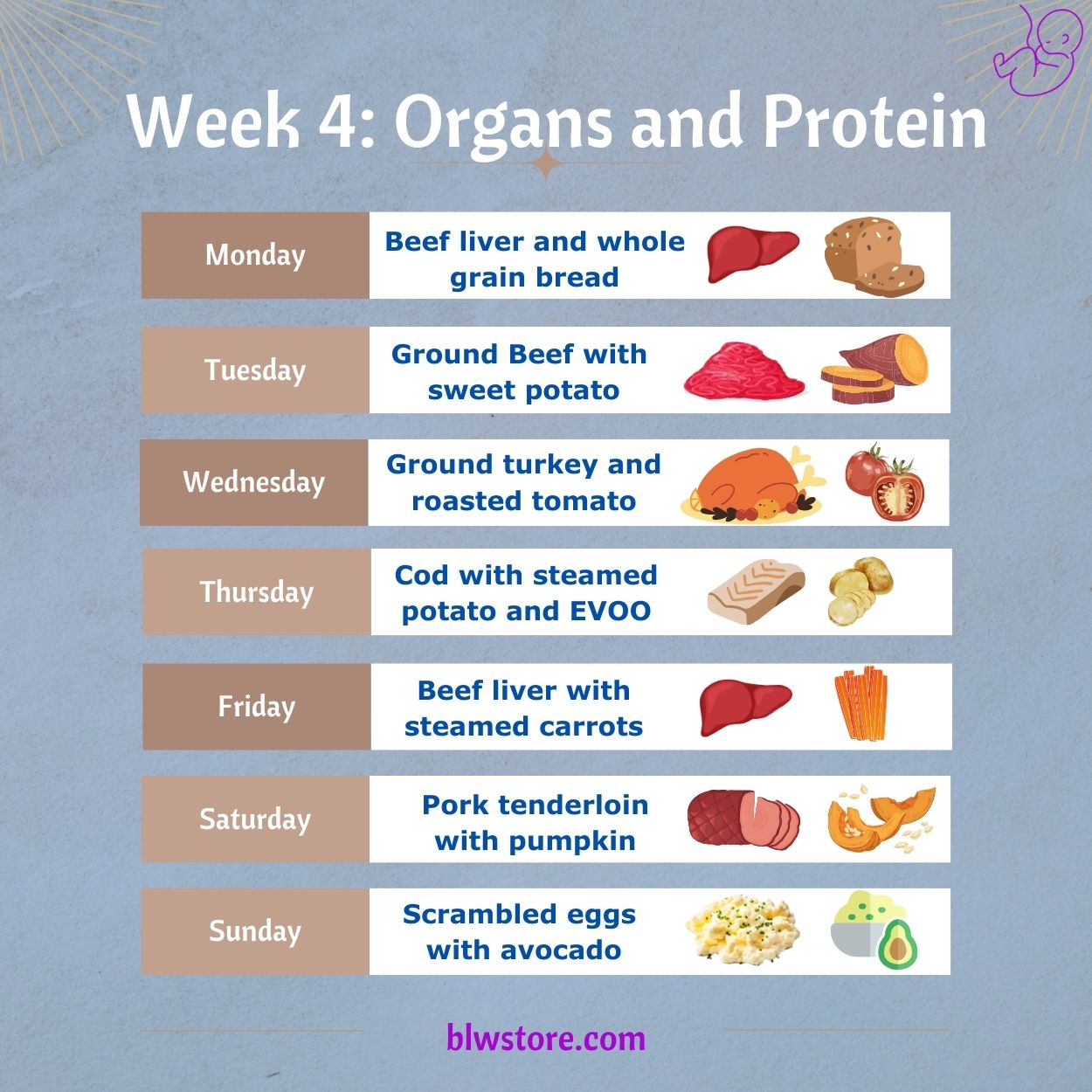
This week’s goal is to widen the variety of your baby’s palate, promoting healthy eating habits and ensuring they get a range of nutrients. We’ll focus on introducing organs and more sources of protein.
Remember, always observe your baby’s eating habits, and if they show signs of discomfort with any food, revert to previous weeks’ food items and gradually reintroduce the new ones.
| Day | Meal Plan |
|---|---|
| Day 1 | Beef liver with whole grain bread |
| Day 2 | Ground beef with mashed sweet potato and spices |
| Day 3 | Ground turkey and roasted tomato |
| Day 4 | Cod with steamed potato with EVOO |
| Day 5 | Lamb with soft-cooked carrots |
| Day 6 | Pork tenderloin with pumpkin |
| Day 7 | Scrambled eggs with avocado |
Remember: All new foods should be introduced one at a time and spread over 2-3 days. This is to allow you to watch for any allergic reactions.
To make this week successful, you might need to:
- Persist with new foods and flavors even if they initially reject them. Babies might need numerous exposures to a new food before accepting it, so don’t stress.
- Offer small meals with varied textures to practice the chewing motion.
- Let your child get messy. They are just as interested in feeling, squishing, dropping and seeing the food as they are in tasting it. This is all part of the learning process.
Beyond the First Month: Progressing in Baby-Led Weaning
By the end of the first month of Baby-Led Weaning (BLW), your baby will have experienced a selection of simple, individual foods and some mixed flavors. You will have also introduced some basic grains.
Now, it’s time to introduce a wider variety of foods to your baby.
Week 5 and onwards is when the fun really begins!
You’ll start combining multiple food groups into single meals, begin to experiment with new shapes and textures, and introduce new foods more regularly while also including previous ones to reaffirm their familiarity.
But remember, your baby should set the pace.
Sample Week 5 Meal Plan
| Day | Breakfast | Lunch | Dinner |
|---|---|---|---|
| Monday | Veggie omelette strips | Chicken, broccoli & sweet potato cubes | Ground beef with cooked peas & carrot sticks |
| Tuesday | Pear & banana slices | Lentil & vegetable soup | Salmon with quinoa & zucchini slices |
| Wednesday | Avocado & toast fingers | Beef stew with bread pieces | Turkey & spinach meatballs with pasta |
| Thursday | Oatmeal & ripe peach slices | Quinoa with cooked bell pepper & tomato | Beef liver & broccoli with rice cakes |
| Friday | Banana & blueberry pancakes | Lentil & carrot salad | Steamed fish with sweet potato & green beans |
As your baby adjusts to their expanding palate, don’t forget about the important role that breastfeeding or formula-feeding plays during this time. It continues to be the primary source of nutrition until they’re around one year.
Tips for Success Beyond the First Month
- Explore the rainbow: Aim to include a variety of colors in your baby’s meals. This makes mealtime visually exciting for them and ensures they get a wide range of nutrients.
- Keep track: It’s easy to lose track, especially when introducing new foods regularly. Use a food diary to note any potential allergies or intolerances.
- Include spices and herbs: Beyond the first month of BLW, you can gradually introduce mild herbs and spices to add different flavors. For instance, garlic, cinnamon, basil, or mild curry powder can be started in small amounts.
In essence, let your baby enjoy their journey to a flavorful and nourishing world of food. As long as they’re not losing interest or becoming overwhelmed, keep introducing variety, one step at a time.
We’re Maria and Alberto, a married couple and educators who are nutrition enthusiasts. Even before we had kids, we were already crazy about nutrition.
We’d read scientific articles, watch videos from nutritionists, and spend hours listening to nutrition podcasts.
Today, we continue doing this, but in a different way, as we’ve learned to sift through the noise and trends. Nutrition, like any other field of knowledge, the more you read and learn, the more you develop a comprehensive understanding of reality, and that’s what has happened to us.
Before having our first child, we focused on learning everything we could about child nutrition, using the same techniques we had already employed, backed by our extensive knowledge in nutrition.
Our mission is to help other parents with their children’s nutrition, to help them become the best versions of themselves.
If we are what we eat and drink, which is absolutely true, let’s do it right!



